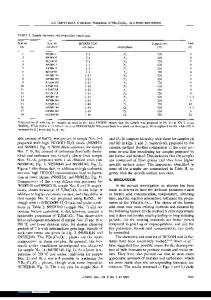Preparation of NiNb 2 O 6 Columbite Ceramics by a Reaction-Sintering Process
- PDF / 550,424 Bytes
- 5 Pages / 595 x 842 pts (A4) Page_size
- 50 Downloads / 405 Views
FF3.5.1
Preparation of NiNb2O6 Columbite Ceramics by a Reaction-Sintering Process Yi-Cheng Liou and Chao-Yang Shiue Department of Electronic Engineering, Kun-Shan University of Technology, Tainan Hsien 710, Taiwan, R.O.C. ABSTRACT Preparation of NiNb2O6 columbite ceramics by a reaction-sintering process has been investigated. The mixture of raw materials was pressed and sintered into ceramics without any calcination stage involved. Columbite NiNb2O6 ceramics were obtained after being sintered at 1250-1450oC for 2 h and 4 h from mixture of Nb2O5 and 50%Ni(NO3)2-50%NiO (NN1). In pellets from mixture of Nb2O5 and NiO (NN2), columbite NiNb2O6 ceramics were obtained after being sintered at 1150-1350oC for 2 h and 4 h. A density of 4.47 g/cm3 was obtained in NN1 for 2 h sintering at 1400oC. For NN2, a higher density 5.62 g/cm3 (99.8% of the theoretical value) was obtained for 2 h sintering at 1300oC. The reaction-sintering process has proven to be a simple and effective method in preparing columbite NiNb2O6 ceramics. A higher density could be obtained at lower sintering temperature by using NiO instead of 50%Ni(NO3)2-50%NiO in the reaction with Nb2O5. INTRODUCTION Microwave dielectric resonators have been widely investigated due to the fast growth of satellite and mobile communication systems [1,2]. Complex perovskite compounds Ba(Zn1/3Ta2/3)O3 (BZT) and Ba(Mg1/3Ta2/3)O3 (BMT) were reported to exhibit excellent microwave dielectric properties [3, 4]. However, fairly high sintering temperatures are needed to obtain these complex perovskite ceramics. Besides, Ta2O5 is an expensive raw material as compared with Nb2O5. The columbite niobate compounds MNb2O6 (where M= Mg, Zn, Ni, Ca, Cu, Mn and Co) have received much attention due to low sintering temperature and low cost [5-8]. ZnNb2O6 (ZN) ceramics were reported to exhibit excellent dielectric properties (єr=25, Qxf=83700GHz and τf=-56.1ppm/oC). For the NiNb2O6 ceramics, єr~22.6, Qxf~40100GHz and τf~-38ppm/oC were reported [6]. Therefore, they are investigated for the applications in microwave dielectric resonators. A novel mechanochemical processing route has been used to produce ZN and MgNb2O6 (MN) [9,10]. In this mechanical technique, the powder of reactants are homogenized and activated in high-energy vibromill. Several materials such as BaTiO3 (BT), PbTiO3 (PT), Pb(Zr,Ti)O3 (PZT) and Pb(Mg1/3Nb2/3)O3 (PMN) were prepared by using this process [11-15]. The reaction-sintering process is a simple and effective route to synthesize ceramics. The calcination step is bypassed and the mixture of the raw materials is sintered directly. Kong and Ma proposed PZT ceramics prepared by sintering the oxide mixture directly [16]. Almost at the same time, Liou et al. proposed reaction-sintering process in preparing PMN, PMN-PT and Pb(Fe0.5Nb0.5)O3 (PFN) ceramics [17-19]. These are the first successful synthesis of perovskite relaxor ferroelectric ceramics without having to go through the calcination step or the high-energy milling. PMN ceramics with a density of 8.09 g/cm3 (99.5% of the
Data Loading...











